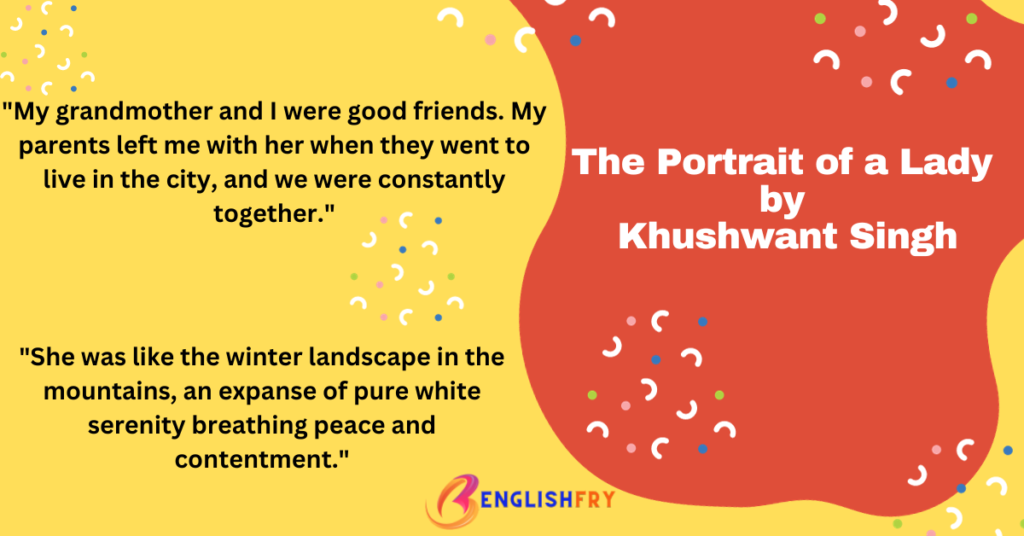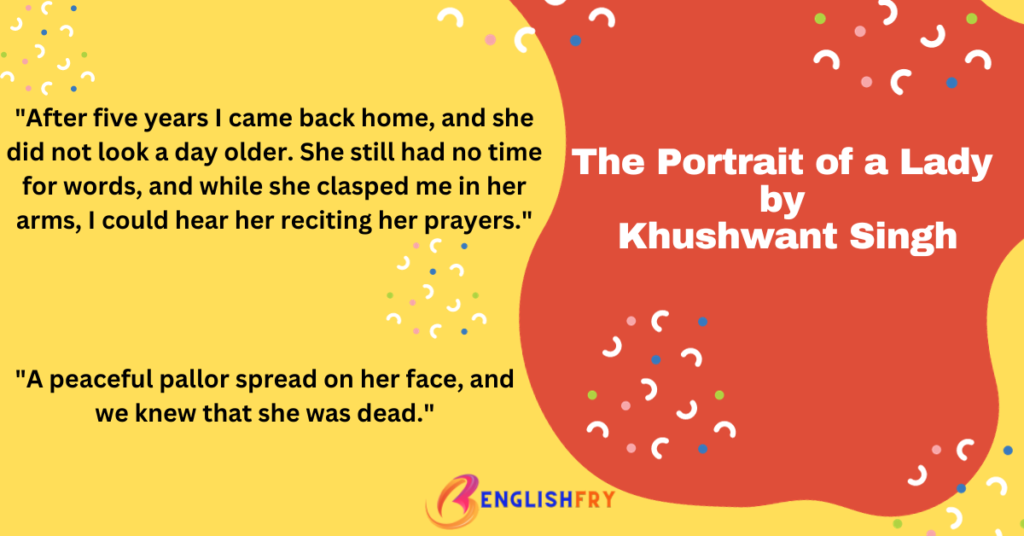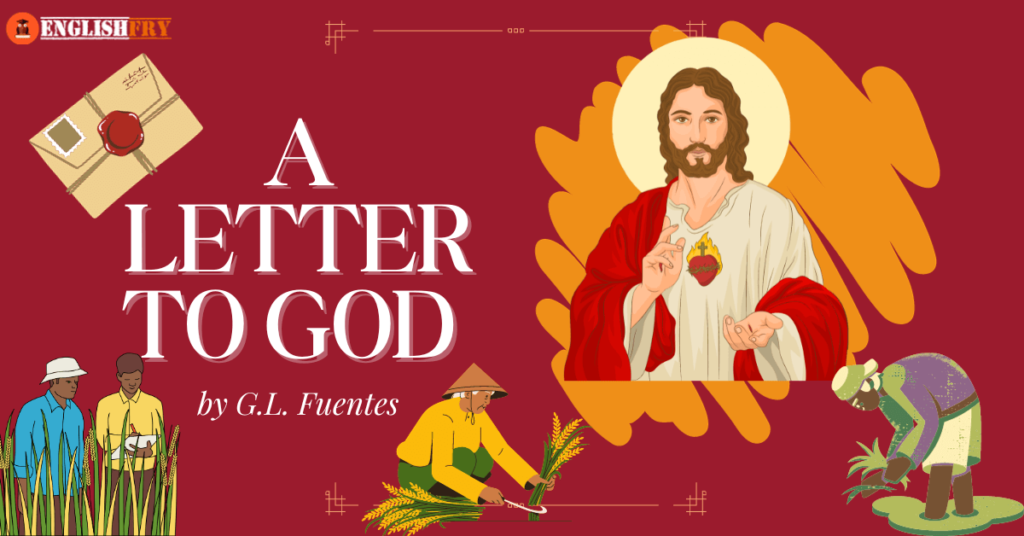Table of Contents
ToggleAbout Khushwant Singh
Khushwant Singh ( born Khushal Singh, 2 February 1915 – 20 March 2014) was an Indian author, lawyer, diplomat, journalist and politician. His experience in the 1947 Partition of India inspired him to write Train to Pakistan in 1956 (made into film in 1998), which became his most well- known novel. Khushwant Singh was one of the prominent Indian writers and columnists. In the story the author draws a pen portrait of his grandmother. He has beautifully written an account of his relationship with his grandmother.
Gists of Lesson The Portrait of a lady
- The story explores the enduring relationship between the narrator and their grandmother.
- Grandmother, always old and wrinkled, is described as a serene and beautiful presence.
- Childhood memories include shared morning routines and walks to school, highlighting a close bond.
- Narrator’s life shifts with a move to the city and attendance at an English school, causing a cultural gap with the traditional grandmother.
- Tension arises as the grandmother disapproves of Western education, particularly music lessons.
- The narrator’s departure for university marks a significant separation, leading to a gradual diminishing of their bond.
- Upon returning, the grandmother remains unchanged, finding solace in feeding sparrows.
- The story takes a poignant turn as the grandmother predicts her imminent death, emphasizing the importance of prayer in her life.
- Her peaceful passing is marked by a unique event: sparrows gathering in her room.
- The lesson encapsulates themes of cultural and generational shifts, the passage of time, and the enduring influence of tradition amidst change.

The Portrait of a Lady Summary Class 11 English
Today, class, let’s embark on a literary journey as we unravel the intricate layers of “The Portrait of a Lady” by the renowned writer, Kushwant Singh. This masterful narrative unfolds as a true story, a poignant account of the author’s grandmother. Her name remains unspoken, yet her presence lingers throughout the tale. Singh, a wordsmith of emotions, invites us into the realms of his childhood, where every moment with his grandmother is a brushstroke in the canvas of memory.
A Glimpse into the Writer’s Youth
As we delve into the heart of the matter, Singh intricately weaves a tapestry of love and growth. His narrative unfolds like a delicate dance between the past and the present, revealing the evolution of a relationship. We witness the author’s contemplation on his grandmother’s daily rituals, her character maturing like a fine wine over the years. Singh, with the precision of an artist, paints vivid images that etch themselves in our minds, creating a lasting impression of his grandmother.
Themes Across Life’s Stages
Now, let’s dissect the thematic richness embedded in this narrative. In the innocence of childhood, we encounter the tender themes of love and admiration. A bond shared between a grandmother and her grandson flourishes like a blooming flower. Yet, with the shift to the bustling city, themes of separation and unfamiliarity creep in, mirroring the complexities of life. The tale takes a poignant turn upon the writer’s return from abroad, introducing us to the themes of reunion and a bittersweet ending, tugging at our heartstrings.
Grandmother’s Image Etched in Memory
Visualize with me, if you will, the writer’s vivid recollections of his grandmother. Short in stature, yet emanating health, with silver hair cascading haphazardly over her wrinkled face. Dressed in white, she moved gracefully through the household, one hand on her waist, the other engaged in the rhythmic recitation of her rosary. Despite not conforming to conventional standards of beauty, the writer perceives her as a timeless embodiment of beauty, likening her calm face to the serene winter landscape.
Village Days: Routine
Transport yourself to their village days, where every sunrise marked a harmonious routine orchestrated by the grandmother. She played the role of guardian, waking the writer early, organizing breakfast, and sending him off to school. The village temple became a sanctuary of learning, a shared space where sacred texts were studied alongside the alphabet.
The City Shift: A Turning Point
Now, envision the turning point as they transition to city life. Despite sharing physical space, the bonds between the writer and his grandmother start to fray. The writer’s education takes a different trajectory, delving into subjects beyond his grandmother’s comprehension. A schism emerges, and the once inseparable duo drifts apart.
University Days: The Breaking Point
As the writer steps into the realm of university life, the once unbreakable link between grandson and grandmother snaps. Solitude engulfs the grandmother, accepting her isolation as she immerses herself in prayer and the rhythmic hum of her spinning wheel.

The Journey Abroad and Return
Fast forward to the writer’s journey abroad for further studies. A silent farewell ensues at the train station, with the grandmother masking her inner turmoil. Yet, the narrative takes an unexpected twist upon the writer’s return after five years, revealing a celebration that echoes the joy of a heartfelt reunion.
The Poignant Farewell
Our hearts ache as we confront the inevitable. The morning after the joyous reunion, the grandmother falls ill. Despite the doctor’s reassurances, she senses the proximity of her final journey. Engulfed in prayer, she succumbs to the inevitable, leaving behind a scene where thousands of sparrows pay their silent respects.
Word Meanings
| Word | Meanings |
|---|---|
| Mantelpiece | A structure of wood, marble, or stone |
| Hobbled | Walked in an awkward or lame way. |
| Stoop | Bend one's body forward. |
| Rosary | A string of beads for keeping count of the number of chants made during a religious prayer. |
| Puckered | A face contracted into wrinkles. |
| Stale | No longer fresh and pleasant to eat; hard, musty, or dry. |
| Wrinkled | Having lines or folds on the surface. |
| Serenity | The state of being peaceful and calm. |
| Monotonous | Dull and boring, lacking in variety. |

The Portrait of a Lady Summary in Hindi
खुशवंत सिंह ने यहां अपनी दादी का दिलचस्प चित्र बनाया है। वह उसे एक कोमल, प्रेमपूर्ण और गहरी धार्मिक वृद्ध महिला के रूप में प्रस्तुत करता है। सिंह का कहना है कि उनकी दादी एक वृद्ध महिला थीं। वह इतनी बूढ़ी थी कि उसके चेहरे पर झुर्रियाँ पड़ गई थीं कि इस समय यह विश्वास करना कठिन था कि वह कभी जवान और सुंदर रही होगी।
उसके बाल बर्फ की तरह सफेद थे. उसकी पीठ थोड़ी झुकी हुई थी। वह हर वक्त माला जपती नजर आ रही थीं. लेखक का कहना है कि “वह पहाड़ों में सर्दियों के परिदृश्य की तरह थी और शांति और संतुष्टि में सांस लेने वाली शुद्ध सफेद शांति का प्रतीक थी।” लेखक के दादा की एक तस्वीर दीवार पर टंगी हुई थी। वह बहुत बूढ़ा लग रहा था और ऐसा लग रहा था कि उसकी कभी कोई पत्नी भी थी।
ऐसा प्रतीत होता है कि उसके पास बहुत सारे पोते-पोतियाँ ही हैं। उस समय सिंह एकमात्र संतान थे। उनके माता-पिता उन्हें उनकी दादी की देखरेख में गाँव में छोड़कर शहर में रहने चले गये थे। वह उसे स्कूल के लिए तैयार करेगी। और उसे रोटी भी खिलाएंगे. स्कूल एक मंदिर से जुड़ा हुआ है। सभी बच्चे बरामदे में बैठकर अक्षर पाठ कर रहे थे जबकि उसकी दादी पवित्र ग्रंथ पढ़ने में लगी हुई थीं। अंततः शाम को, लेखिका और दादी कुत्तों को खाना खिलाते हुए घर वापस चली गईं।
खुशवंत सिंह को अपनी दादी से दोस्ताना रिश्ते के बाद शहर में नई जिंदगी अपनानी पड़ी। यह अपने आप में दादी और पोते के लिए एक महत्वपूर्ण मोड़ था। उन दोनों को उसके माता-पिता के साथ शहर में बसने के लिए भेजा गया था। लेखक एक अंग्रेजी स्कूल में गया लेकिन उसकी पढ़ाई का तरीका दादी को कभी पसंद नहीं आया। हालाँकि सिंह और उनकी दादी एक ही कमरे में रहते थे, लेकिन वह उनकी मदद करने में असमर्थ थीं।
इसके अलावा, वह इस बात से भी निराश थी कि वह संगीत सीख रहा था जिसे वह सज्जन लोगों के लिए नहीं मानती थी।कुछ समय बाद, सिंह एक विश्वविद्यालय में चले गए और इस वजह से, उन्हें एक अलग कमरा दिया गया। इससे वास्तव में उनके रिश्ते का सामान्य संबंध पूरी तरह से टूट गया। दादी इस बात से सहमत थीं और इसकी भरपाई के लिए वह सूर्योदय से सूर्यास्त तक चरखा चलाती थीं। केवल दोपहर के समय वह गौरैयों को रोटी के छोटे-छोटे टुकड़े खिलाकर आराम करती थी।
वे उसके सबसे अच्छे दोस्त थे और गौरैया को भी उसका साथ पसंद था।बाद में, सिंह उच्च अध्ययन के लिए विदेश चले गए जो 5 वर्षों के लिए था। उसके मन में यह शंका थी कि उसके वापस आने तक उसकी दादी जीवित रह पायेगी या नहीं। उसने यह भी सिखाया कि यह उन दोनों के बीच आखिरी शारीरिक संपर्क हो सकता है जब वह उसे छोड़ने के लिए रेलवे स्टेशन पर आई थी।
5 साल बाद वह वापस आया, अविश्वसनीय रूप से उसकी दादी ने उसका स्वागत किया, जो एक दिन भी बड़ी नहीं हुई थी। सिंह ने देखा कि इस समय भी जब हर कोई उसकी वापसी को लेकर खुश था, दादी के लिए सबसे खुशी के पल अपनी गौरैयों के साथ थे। देर शाम उनके रवैये में बदलाव आया। उन्होंने अपने पोते की वापसी का जश्न मनाया और पड़ोस की कुछ महिलाओं को इकट्ठा किया और पिटाई की। कई घंटों तक ढोल बजाते रहे. लेकिन सुबह दादी की तबीयत खराब हो जाती है और उन्हें पता चलता है कि वह अपने अंत के करीब हैं।
इसलिए उसने फैसला किया कि वह बात करके एक भी पल बर्बाद नहीं करेगी इसलिए उसने प्रार्थना की।तभी अचानक उसके हाथ से माला गिर गई और उसने अपनी आखिरी सांस छोड़ी और यह स्पष्ट हो गया कि वह अब नहीं रही। अंतिम संस्कार की तैयारी करने के बाद परिवार के लोग अंतिम यात्रा के लिए उसका शव लाने चले गए। डूबते सूरज की सुनहरी रोशनी ने उसके कमरे को चमका दिया।
और दादी को अंतिम श्रद्धांजलि देने के लिए हजारों गौरैया उनके कमरे और उसके आसपास इकट्ठा हो गईं। गौरैयों ने कभी खुशियां नहीं मनाईं और न ही कोई सामान्य काम किया। वे उन पर फेंके गए पढ़े गए अंशों पर ध्यान देने की जहमत भी नहीं उठाते। उसके अंतिम संस्कार के साथ ही गौरैया उड़ गयीं।

The Portrait of a Lady Summary in Assamese
খুশৱন্ত সিঙে ইয়াত তেওঁৰ আইতাকৰ এক আকৰ্ষণীয় প্ৰতিকৃতি অংকন কৰিছে। তেওঁ তাইক এগৰাকী কোমল, মৰমিয়াল আৰু গভীৰভাৱে ধৰ্মীয় বৃদ্ধা হিচাপে উপস্থাপন কৰে। সিঙে কয় যে আইতাক এগৰাকী বুঢ়ী আছিল। তাই ইমানেই বুঢ়া হৈ পৰিছিল যে তাইৰ মুখখন বলিৰেখাৰ দৰে হৈ পৰিছিল যে বৰ্তমান সময়ত তাই কেতিয়াও সৰু আৰু ধুনীয়া হ’লহেঁতেন বুলি বিশ্বাস কৰাটো কঠিন হৈ পৰিছিল।
তাইৰ চুলিখিনি বৰফৰ দৰে বগা হৈ পৰিছিল। তাইৰ পিঠিত অলপ কুঁজা আছিল। তাই সকলো সময়তে ৰোজাৰী আবৃত্তি কৰা দেখি থাকিব পাৰে। লেখকে কয় যে “তাই আছিল পাহাৰৰ শীতকালীন প্ৰাকৃতিক দৃশ্য আৰু শান্তি আৰু সন্তুষ্টিৰ উশাহ লোৱা বিশুদ্ধ বগা নিশ্চিন্ততাৰ উন্মোচনৰ দৰে।”বেৰত ওলোমাই থোৱা আছিল লেখকৰ দাদাৰ এখন ছবি।
তেওঁক বৰ বুঢ়া যেন লাগিছিল আৰু সেয়া আছিল যে তেওঁৰ কেতিয়াবা পত্নী আছিল। তেওঁৰ মাত্ৰ বহুত বহুত নাতি-নাতিনী থকা যেন লাগিল। সেই সময়ত সিং একমাত্ৰ সন্তান। মাক-দেউতাকে আইতাকৰ তত্বাৱধানত গাঁৱৰ পিছফালে এৰি চহৰত থাকিবলৈ গৈছিল। তাই তাক স্কুললৈ সাজু কৰি দিব। আৰু চাপথীও খুৱাব। মন্দিৰৰ সৈতে সংলগ্ন হিচাপে বিদ্যালয়।
আইতাক পবিত্ৰ শাস্ত্ৰ পাঠত নিয়োজিত হৈ থকাৰ সময়তে সকলো ল’ৰা-ছোৱালীয়ে বাৰাণ্ডাত বহি বৰ্ণমালা পাঠ কৰিছিল। অৱশেষত সন্ধিয়া লেখিকা আৰু আইতাই কুকুৰক খুৱাই ঘৰলৈ খোজ কাঢ়ি উভতি আহিছিল।খুশৱন্ত সিঙে আইতাকৰ সৈতে বন্ধুত্বপূৰ্ণ সম্পৰ্কৰ অন্তত চহৰত নতুন জীৱন ধাৰণ কৰিবলগীয়া হয়।
এইটো নিজেই আইতা আৰু নাতিৰ বাবে এটা টাৰ্নিং পইণ্ট আছিল। দুয়োকে পিতৃ-মাতৃৰ সৈতে চহৰত বসতি স্থাপন কৰিবলৈ মাতি পঠিওৱা হ’ল। লেখক ইংৰাজী স্কুল এখনত পঢ়িছিল যদিও তেওঁক পঢ়োৱাৰ ধৰণটো আইতাই কেতিয়াও ভাল নাপালে। যদিও সিং আৰু আইতাক একেটা কোঠাতে আছিল, তথাপিও তাই তেওঁক সহায় কৰিব পৰা নাছিল। ইয়াৰ উপৰিও তাই হতাশ হৈছিল যে সি এনেকুৱা সংগীত শিকিছে যিটো তাই ভদ্ৰলোকৰ বাবে নহয় বুলি গণ্য কৰিছিল।
সময়ত সিং এটা বিশ্ববিদ্যালয়লৈ উঠি গ’ল আৰু তাৰ বাবেই তেওঁক এটা সুকীয়া কোঠা দিয়া হ’ল।ইয়াৰ ফলত সঁচাকৈয়ে তেওঁলোকৰ সম্পৰ্কৰ সাধাৰণ সংযোগটো সম্পূৰ্ণৰূপে ছিন্নভিন্ন হৈ পৰিল। আইতাই কথাটো মানি লৈছিল আৰু তাৰ ক্ষতিপূৰণ দিবলৈ তাই সূৰ্য্য উদয়ৰ পৰা সূৰ্যাস্তলৈকে চকাটো ঘূৰাইছিল। দুপৰীয়াৰ ভাগতহে তাই চৰাইবোৰক সৰু সৰু ৰুটিৰ টুকুৰাৰে খুৱাই জিৰণি লৈছিল। সিহঁত তাইৰ বেষ্ট ফ্ৰেণ্ড আছিল আৰু চৰাইবোৰেও তাইৰ সংগ ভাল পাইছিল।
পিছত সিং উচ্চ পঢ়াৰ বাবে বহিঃৰাজ্যলৈ উঠি যায় যিটো ৫ দীঘলীয়া বছৰৰ বাবে আছিল। তাৰ মনত এটা সন্দেহ আছিল যে সি ঘূৰি অহালৈকে আইতাক বাচি থাকিব পাৰে নে নাই। তাৰ লগতে শিকাইছিল যে তাই ৰেলৱে ষ্টেচনত তাক বিদায় দিবলৈ অহাৰ সময়ত সিহঁতৰ মাজত শেষ শাৰীৰিক সংস্পৰ্শ হ’ব পাৰে। ৫ বছৰৰ পাছত তেওঁ উভতি আহিল, অবিশ্বাস্যভাৱে তেওঁক আদৰণি জনাইছিল আইতাকেই যিগৰাকী এদিনো ডাঙৰ হোৱা নাছিল।
সিঙে লক্ষ্য কৰে যে এই সময়তো যেতিয়া সকলোৱে তেওঁৰ উভতি অহাৰ বাবে আনন্দত থাকে তেতিয়াও আইতাৰ আটাইতকৈ সুখৰ মুহূৰ্তবোৰ আছিল তাইৰ চৰাইৰ লগত।পিছলৈ সন্ধিয়া তাইৰ মনোভাৱৰ পৰিৱৰ্তন ঘটিছিল।তাই নাতিৰ উভতি অহাৰ আনন্দ উদযাপন কৰিছিল y চুবুৰীৰ কিছুমান মহিলাক সংগ্ৰহ কৰি মাৰপিট কৰিছিল কেইবা ঘণ্টা ধৰি ড্ৰাম মাৰিব।
কিন্তু ৰাতিপুৱা আইতাকৰ স্বাস্থ্যৰ অৱনতি ঘটে আৰু তাই প্ৰকাশ কৰে যে তাইৰ শেষৰ ফালে আহিছিল। গতিকে তাই সিদ্ধান্ত লয় যে তাই কথা পাতি এটাও মুহূৰ্ত নষ্ট কৰিবলৈ যোৱা নাই গতিকে তাই প্ৰাৰ্থনা কৰিলে।যথেষ্ট হঠাতে তাইৰ হাতৰ পৰা ৰোজাৰীখন সৰি পৰে আৰু তাই শেষ উশাহ এৰিলে আৰু স্পষ্ট হৈ পৰিল যে তাই আৰু নাই।
অন্ত্যেষ্টিক্ৰিয়াৰ প্ৰস্তুতি চলোৱাৰ পিছত পৰিয়ালৰ লোকে শেষ যাত্ৰাৰ বাবে তাইৰ মৃতদেহ আনিবলৈ গৈছিল। অস্ত যোৱা সূৰ্য্যৰ পোহৰৰ সোণালী জুইকুৰাটোৱে তাইৰ কোঠাটো জিলিকি উঠিছিল। আৰু আইতাকক শেষ শ্ৰদ্ধাঞ্জলি জনাবলৈ তাইৰ কোঠাৰ ভিতৰত আৰু চাৰিওফালে হাজাৰ হাজাৰ চৰাই গোট খালে। চৰাইবোৰে কেতিয়াও উল্লাস কৰা নাছিল আৰু স্বাভাৱিক কামো কৰা নাছিল। তেওঁলোকৰ ওপৰত নিক্ষেপ কৰা পঢ়া টুকুৰাবোৰ লক্ষ্য কৰিবলৈও আমনি নকৰে। তাইৰ অন্ত্যেষ্টিক্ৰিয়াৰ লগে লগে চৰাইবোৰ উৰি গ’ল।

The Portrait of a Lady MCQs
1.What is the condition of the grandmother’s portrait?
- A) Clear and vivid
- B) Covered in wrinkles
- C) Hidden away
- D) Colorful attire
Answer: B) Covered in wrinkles
2.How does the narrator describe the grandmother’s face?
- A) Smooth and flawless
- B) Covered in makeup
- C) A criss-cross of wrinkles
- D) Hidden behind a veil
Answer: C) A criss-cross of wrinkles
3.What was the narrator’s breakfast before going to school?
- A) Fresh fruit
- B) Stale chapatti with butter and sugar
- C) Cereal with milk
- D) Pancakes with syrup
Answer: B) Stale chapatti with butter and sugar
4.Why does the grandmother accompany the narrator to school initially?
- A) To meet the teacher
- B) To feed village dogs
- C) The school is attached to the temple
- D) To buy school supplies
Answer: C) The school is attached to the temple
5.What causes a change in the narrator’s friendship with the grandmother?
- A) Narrator moving to the city
- B) Grandmother’s disapproval of English education
- C) Introduction of music lessons
- D) All of the above
Answer: D) All of the above
6.What is the grandmother’s reaction to the narrator’s education in English school?
- A) Approval
- B) Indifference
- C) Disapproval
- D) Excitement
Answer: C) Disapproval
7.What event marks the first time the grandmother does not pray?
- A) Narrator’s departure for university
- B) Introduction of music lessons
- C) Unexpected drumming and singing
- D) Grandmother’s illness
Answer: C) Unexpected drumming and singing
8.How does the grandmother spend most of her time after the narrator goes to university?
- A) Praying in the temple
- B) Reading scriptures
- C) Spinning and reciting prayers
- D) Feeding sparrows
Answer: C) Spinning and reciting prayers
9.What marks the change in the grandmother’s daily routine?
- A) Narrator’s departure for university
- B) Introduction of music lessons
- C) Unexpected drumming and singing
- D) Grandmother’s illness
Answer: A) Narrator’s departure for university
10.How does the story describe the grandmother’s passing?
- A) Unexpected and sudden
- B) Peaceful, praying and telling beads
- C) Tragic and dramatic
- D) Painful and prolonged
Answer: B) Peaceful, praying and telling beads
11.What was the atmosphere like during the grandmother’s cremation?
- A) Joyful celebration
- B) Solemn mourning
- C) Chaotic and noisy
- D) Silent and peaceful
Answer: D) Silent and peaceful
12.What did the sparrows do when the narrator’s grandmother passed away?
- A) Left the room immediately
- B) Chirruped loudly
- C) Gathered quietly in the room
- D) Attacked each other
Answer: C) Gathered quietly in the room
13.What was the grandmother’s reaction to the narrator going abroad for studies?
- A) Upset and emotional
- B) Sentimental and talkative
- C) No reaction, she accepted it silently
- D) Excited and proud
Answer: C) No reaction, she accepted it silently
14.What did the grandmother find distressing about the narrator’s education?
- A) Lack of focus on English
- B) Introduction of music lessons
- C) Emphasis on science
- D) The absence of prayer
Answer: B) Introduction of music lessons
15.What is the significance of the grandfather’s portrait in the story?
- A) It’s the narrator’s favorite painting
- B) It symbolizes the passage of time
- C) It depicts a happy family
- D) It’s irrelevant to the narrative
Answer: B) It symbolizes the passage of time
16.What marked the beginning of the grandmother’s daily relaxation routine?
- A) Feeding village dogs
- B) Reading scriptures
- C) Attending school with the narrator
- D) Feeding sparrows
Answer: D) Feeding sparrows
17.Why did the grandmother stop praying on the last day of her life?
- A) She forgot to pray
- B) She chose not to waste time talking
- C) She was too weak to pray
- D) She lost her faith
Answer: B) She chose not to waste time talking
18.What is the grandmother’s reaction to the narrator’s education in Western science?
- A) Happy and proud
- B) Indifferent
- C) Distressed and unhappy
- D) Supportive
Answer: C) Distressed and unhappy
19.What does the narrator cherish upon leaving for university?
- A) A gift from the grandmother
- B) A book from the grandfather
- C) A last sign of physical contact
- D) A piece of jewelry
Answer: C) A last sign of physical contact
20.How does the grandmother react to the introduction of music lessons?
- A) Excited and supportive
- B) Disturbed and silent disapproval
- C) Happy and encouraged
- D) Enthusiastic and proud
Answer: B) Disturbed and silent disapproval

The portrait of a lady class 11 extra questions with answers
Question1. The grandmother has been portrayed as a very religious lady. What details in the story create this impression ?
Solution: The author describes his grandmother as short, old, fat and slightly bent. He believed she looked the same for last twenty years. It was difficult for him to imagine her young and pretty. But he found beauty in her old age, like the serene winter landscape.The author recalls his grandmother as a very religious women. He remembers her hobbling in the house, telling the beads of her rosary. He recalls her morning prayers and her reading scriptures inside the temple, The author recounts how, during the last few days, she spent all her time praying.
Question2. “This was the turning point in our friendship.” What was the turning point.
Solution: The turning point in the friendship arrived when they shifted to the city. They saw less of each other as she could neither accompany him to school, nor believe in science. She could not keep pace with the author’s modern education that he received in the city school.
Question3. Describe the author’s grandfather as he looked in his portrait.
Solution: In the portrait, the grand father was dressed in a big turban and loose fitting clothes. His long white beard covered the best part of his chest and he looked at least a hundred years old. He looked grand fatherly to the author, someone who could never have been young. The author described his grandfather with the help of a portrait that hung in the drawing room. In the portrait, the grand father was dressed in a big turban and loose fitting clothes. His long white beard covered the best part of his chest. He looked at least a hundred years old. The author also mentioned(told) that he looked like a person who could never have a wife or children.
Question4. Elaborate on the beautiful bond of love and friendship between the author and his grandmother.
Solution: When the author was young, his parents left for the city living him to the care of his grandmother. They were good friends. She woke him up each morning, bathed him, dressed him, plastered his wooden slate, gave him the breakfast and walked him to school.
While he sat in veranda learning, the grandmother sat inside the temple reading scriptures. When they settled in the city, they shared a common bedroom.
When the writer was going abroad, she went to the railway station to see him off but did not speak a word, only kissed his forehead. The writer cherished this as their last physical contact as he was going away for five years. But his grandmother was there to receive him back.
In the evening, she collected women from his neighborhood and beat the drum and ang for hours of the homecoming of the warriors. For the first time she missed her prayer.
Question 5. Mention how the sparrows expressed their sorrow when the author’s grandmother died.
Answer : The author’s grandmother built a close relationship with the sparrows after she moved to the city. She used to feed the sparrows every day. After her death, she was laid on the floor and covered with a red shroud. When the author and family members came to carry her body, they witnessed thousands of sparrows on the veranda and in her room. They sat quietly on the floor. The author’s mother went inside to bring some bread for the birds. But they didn’t eat the bread crumbs and started to fly away after her body was carried out of the room.
Question 6. Mention Three reasons why the author’s grandmother was disturbed when he started attending the city school.
Answer : Their friendship faded when the author and his grandmother moved to the city. He used to go to school by motor bus, and his grandmother could not take him there. The author used to study English and western science in school. It made her unhappy because she didn’t believe in this study and could not help the author in lessons. The third factor that bothered her the most was the music lessons that the author received in his schools.The lessons were different and not meant for folk songs. It upset her, and she rarely spoke to the author after this.
Question 7. Mention how the author’s grandmother used to feed the birds every day.
Answer : The author’s grandmother had the habit of feeding the dogs while living in the village. When she moved to the city, she could not feed the dogs and started to feed the sparrows. In the afternoon, she used to break the bread into little crumbs and spread it for the birds on the veranda. There used to be hundreds of birds, some sitting on her feet, shoulders and even on her head. That half an hour used to be her best time of the day.
Question 8. Describe how the author’s grandmother reacted when he went to study abroad.
Answer : The author stated that he left for a foreign country for five years to study there. He was aware that it irritated his grandmother.But she came to leave him at the railway station. She showed no emotion or sadness and engaged in prayer. Her mind was lost in prayer, and she kept counting the beads and silently kissing his forehead. In this way, she bid the author goodbye when he left the country.
Question 9. How did the author describe his grandmother?
Answer : The author, Khushwant Singh, had a deep relationship with his grandmother. He spent his childhood with her. He described her grandmother as an older woman like everyone else’s grandmother. He spent his childhood with her. He described her grandmother as an older woman like everyone else’s. He stated that he had known her for as long as he could remember and couldn’t believe she was once so beautiful and young.But he described her as a beautiful woman. He mentioned she was fat, short, and slightly bent. She used to wear white clothes and roam in the house. She used to support her stoop with one hand and count the beads of the rosary with the other. Besides counting, she used to chant a prayer. The author described numerous wrinkles crossing her face and her hair being grey. The silver locks were scattered on her pale face. He compared her to the peaceful, white landscape of a winter mountain.Thus, he described his grandmother and her peaceful beauty.
Question 10. Describe the days when the author lived with his grandmother in the village.
Answer : The author described his childhood friendship with his grandmother. He stated that in his childhood, his parents lived in the city, leaving him with his grandmother. So, he spent his early childhood days with his grandmother and attended the village school run by the priest of the village temple. He remembered his grandmother would wake him up, give him breakfast and get him dressed while singing religious songs. Then he would have his breakfast, which was leftover chapati with sugar and butter. After having breakfast, he would go to school with his grandmother. He would chant the alphabet with other students in chorus, and his grandmother would stay inside the temple reading the scriptures. They would leave home after school when the village dogs met them at the temple door.His grandmother used to carry several chapatis with her, and she would tear the bread to feed the dogs. Thus, the author remembered his colourful childhood days with her grandmother in their village.
Question 11. Describe the changing relationship between the author and his grandmother. Did their feelings for each other change?
Answer: The author had a good friendship with his grandmother. He used to live with her during his childhood days. She used to bathe him, dress him, and take him to school. While he studied at school, she used to stay inside a temple, reading transcripts. After school, they used to return home while feeding the village dogs. Thus, they had a close relationship. But with time, it changed. They moved to the city to live with the author’s parents. The author was admitted to a city school, where he used to travel by bus. As a result, his grandmother was unable to accompany him and remained at home.She was frustrated because she couldn’t help him in his lessons and because the author was receiving western education. They shared the same room, but their conversation got quiet. When the author entered university, she got another room and accepted her seclusion. Following that, he went abroad for studies, causing a schism in their relationship.Though they got farther apart over time, their feelings for each other did not change. He still loved her the same way he did before.His grandmother believed she appeared herself in prayer and reduced conversation with him, and that she had the same love and blessings for him.
Question 12. Explain how the title ‘The Portrait of a Lady’ suits the writing.
Answer: ‘The Portrait of a Lady’ by Khushwant Singh is a remembrance of his grandmother. Here a portrait is mentioned, but it was the portrait of the author’s grandfather. In writing, we find no mention of a picture or photograph of the author’s grandmother. But the writing itself has become a portrait of her. The author didn’t describe her grandmother as a specific person; rather, he stated that she was like everyone else’s grandmother. His relationship with her was also a common one between grandparents and grandchildren. But, the simplicity of it touches the reader’s heart. The details of his memories with his grandmother and her personality vividly depict a caring grandparent. We can know about her personality from the writing. Thus, her picture gets embodied before our eyes due to the author’s description. He didn’t mention her name but represented a woman who strongly adhered to her faith and views. Thus, the lady we study in the story becomes more than a relative of the author. Instead, we learn about a strong older woman who was kind, religious and loved her family. So, the title ‘The Portrait of a Lady’ perfectly suits the writing.
Founder of Englishfry.com, a captivating and knowledge-driven blog & Founder of Android app/website Studyfunnel.com, an online Mock Test Series Portal. With a wealth of experience spanning over 16+ years, he has excelled as an Ex-Asst.Professor, Teacher, Amazon published author, Website Developer, Graphic Designer,Blogger,Poet, and Creative academic content writer publisher of 4 academic books available Online on Amazon & Flipkart. His tryst in Literature helped him realize his love for writing and telling stories. A tech-savvy language nerd by day and, a passionate writer by night, he now translates his experiences into tales of wisdom served with a side of humor.His widely recognized profound insights ,captivating writing style of weaving words make him contribute to prestigious publications and a sought-after authority in the field that transport readers to extraordinary worlds.








